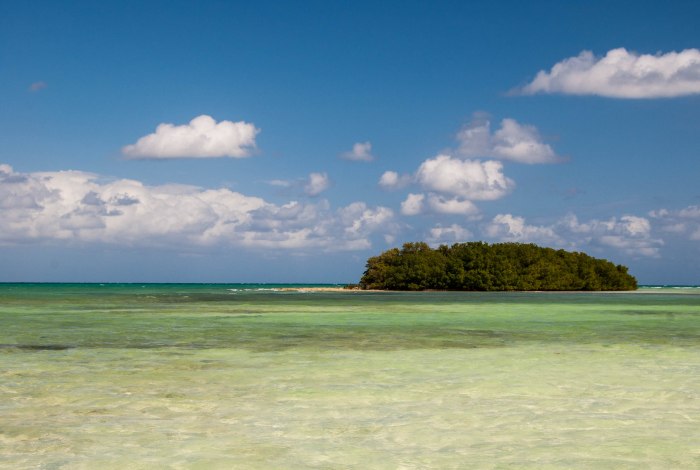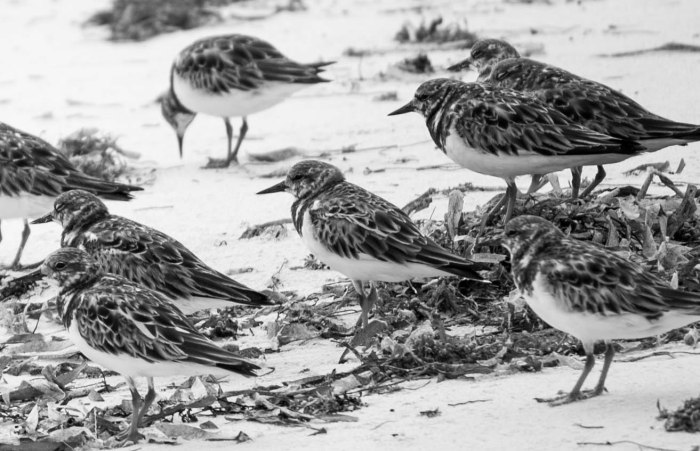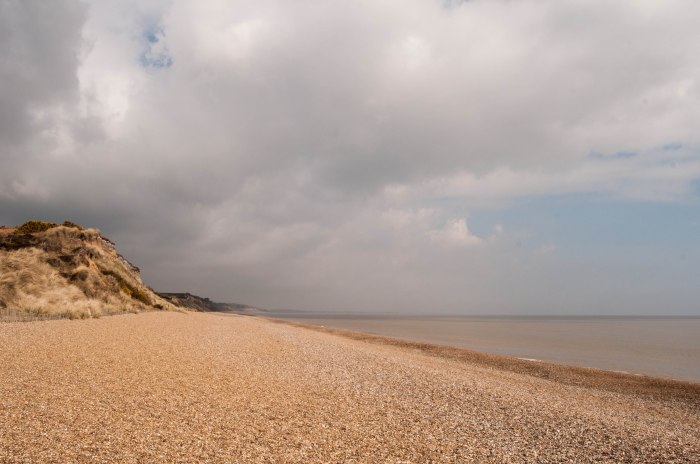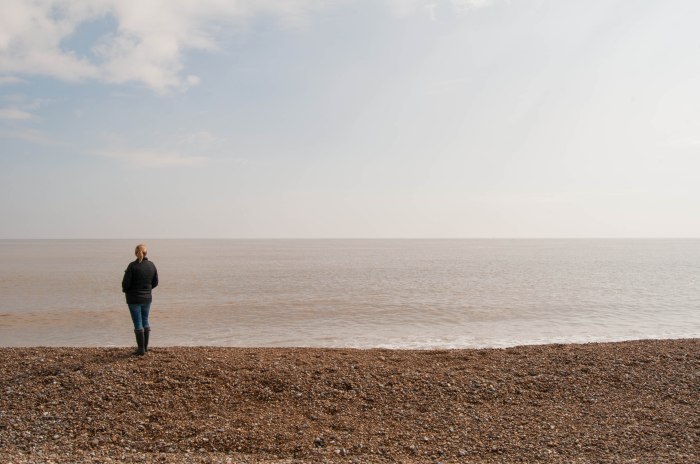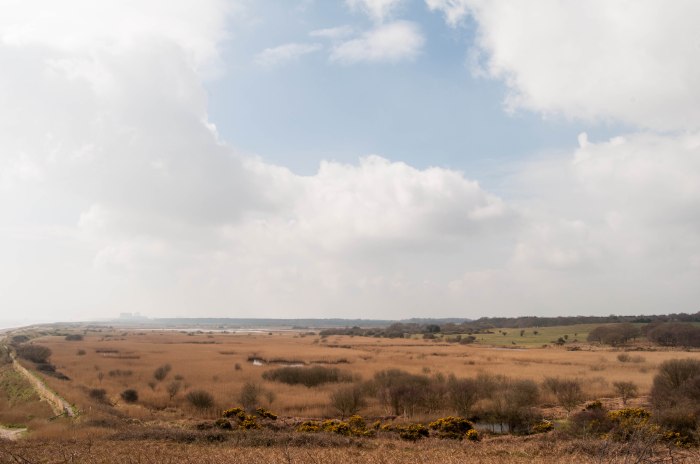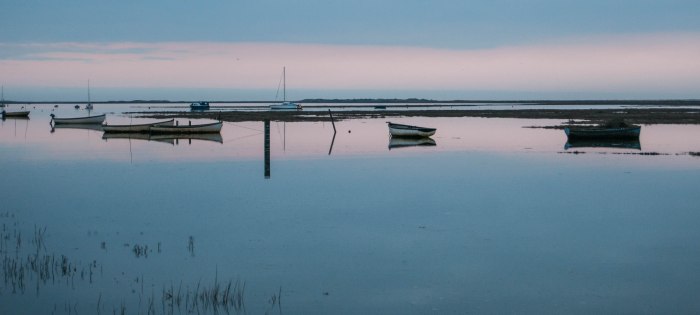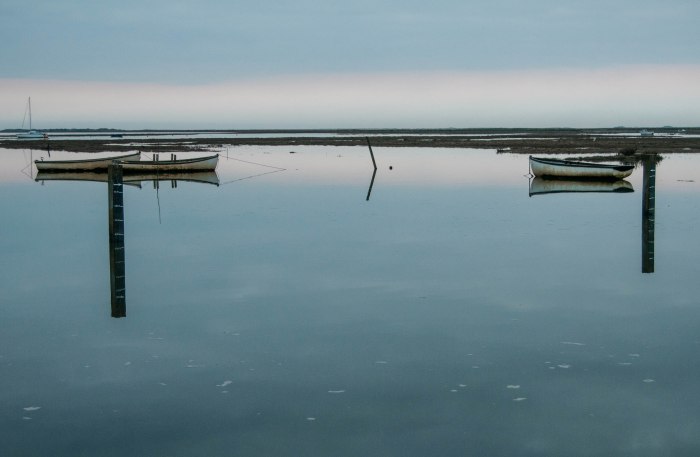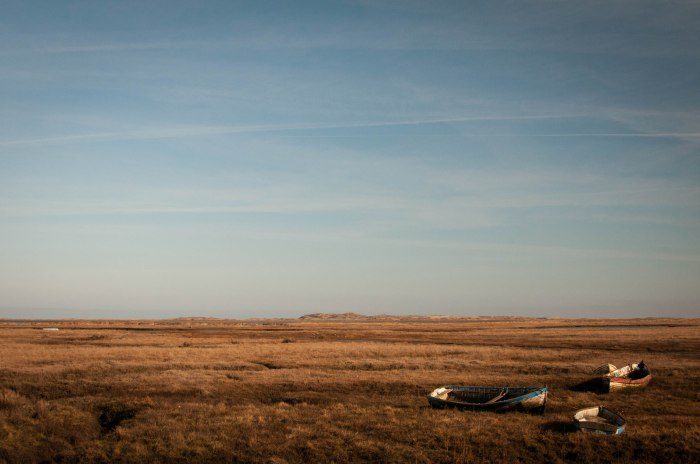I wrote a thing about blackbird song for Caught by the River.
Goose Talk
Since last week I have been hearing the telltale squeal of the pink footed geese as they fly over the house between their roosts out on the marshes at Snettisham, and their feeding grounds inland. This is something I wrote last Winter.
I live literally ten minutes from RSPB Snettisham; it’s the reserve often featured on either Autumn, Winter or Springwatch as the location of the ‘wader spectacular’, and the roosting site – according to my village magazine – of at the moment twenty-five-thousand pink footed geese. I don’t consider myself a birdwatcher in that I don’t go out looking specifically for birds though I do always have a pair of binoculars with me; first and foremost I’m an angler, and it is in this capacity that I get the opportunity to see many different birds. I think it was Isaac Walton who said “Study to be quiet” and it is truly amazing how close to wildlife you can get if you just sit and let it come to you. However, having seen it on the T.V. again the other night I decided it was time I got my backside out of bed a couple of hours before dawn and down to Snettisham to witness it for myself.
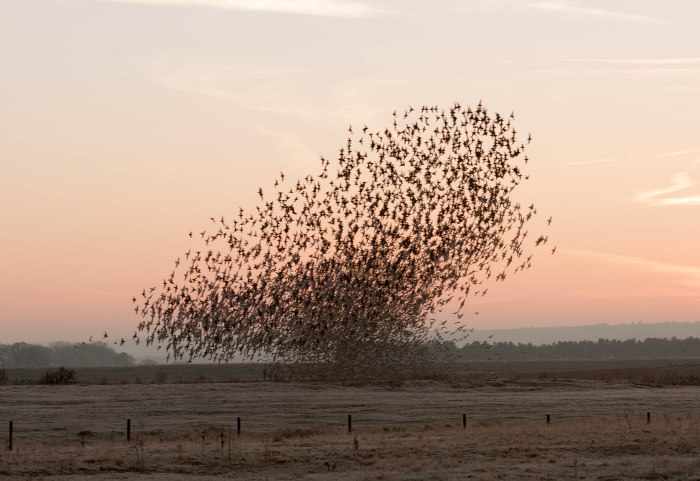
On the highest spring tides, particularly those that occur an hour or two after dawn, the tens of thousands of waders – knot, dunlin, and godwit amongst others – which have been spending the night far out on the mudflats of the Wash get a rather rude awakening as the tide comes in. The Wash is notoriously shallow, which is one of the characteristics that make it such a special place, and for the last hour of the flood tide the sea creeps landward across the mudflats with the same inevitability that also brings the dawn. The dawn this morning brings a pink blush up a swathe of cloud rearing up in the South like a wave. The rest of the sky is clear, and ice hoars every blade of grass like flakes of frosted breakfast cereal.
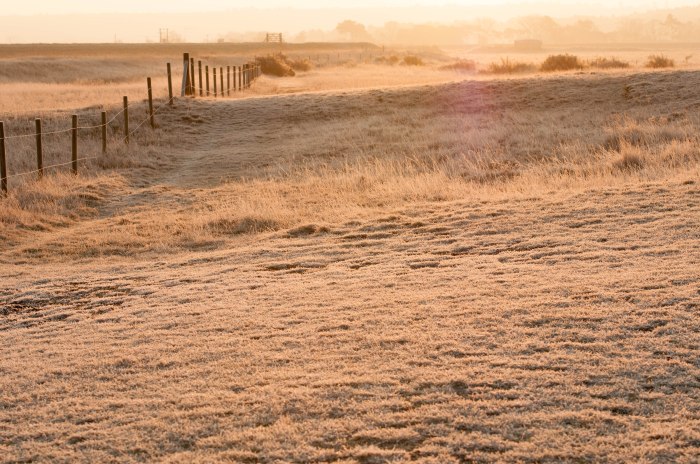
The car park was already full when I arrived even though it was still dark. Walking boots, wellies, hats and gloves are pulled on and we follow, single-file, the narrow path behind one of the saline lagoons that are between us and the seawall, and the row of holiday cottages on top of it, some a little ramshackle looking in the daylight of later. After fifteen minutes or so we climb a bank and see the Wash itself. The dawn is breaking slowly, but the sun itself is still below the horizon to my left.
Far out on the flats, through the dim light, I can see the pink footed geese. From this distance they’re visible as long, dark masses of birds stretched across the flats like lines of indistinguishable handwriting. What is clearer though is the sound: goose talk. There’s an excited note to the twenty-five-thousand-odd pink footed geese that are chattering away to each other, and it genuinely sounds as though they’re having a bit of a chinwag, a bit of a gossip about the coming day; who’s going where and with who; who’s wearing what; like a group of schoolchildren at a bus stop. And then, while I’m still walking to the best view point, right in the very South-East corner of the Wash, the babble rises to a clamour like simmering water coming suddenly to the boil and they’re up; up and flying. A huge morass of black leaps from the mudflats in concert, like an orchestra standing spontaneously for applause, and I wonder which individual bird actually sparked the chain reaction that is now spreading skyward. They stream towards our viewpoint on the shoreline, gaining altitude, and forming themselves into the characteristic v-shape skeins. As they pass overhead their talk settles down into a two-tone squeal designed to keep in touch with the flock, but it’s still an awesome sound and sight as countless thousands of them head inland. For a few minutes they’re visible as long trails of letters across the sky, fading to a blank page as they pass beyond view.
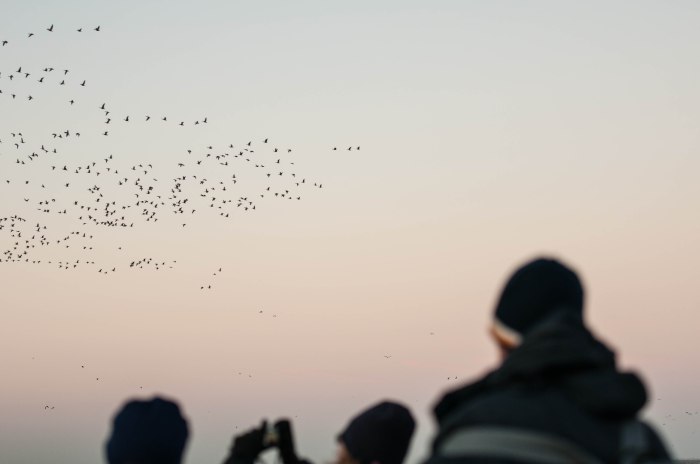
There are a couple of hundred people already spread along the shoreline, binoculars, scopes and lenses all focused intently toward the still-incoming tide being urged on by an onshore wind like a frantic jockey driving his mount to the line. There are still many geese left out there, and now and then a swirl of waders lift off, gather themselves together and with a rush of wings a long, smokey cylinder of birds swoosh low over our heads, and disappear below the lip of the lagoon that is now behind us as we look out across the Wash.
Another huge group of geese lift off to oohs and ahs from the crowd, and follow their predecessors to the feeding grounds inland. Before us the tide has reached the outlying salt marsh and there are now no mudflats left. There is now very little option for the remaining waders but to take to the wing. At first they are just a huge collection of birds in roughly the same vicinity, but suddenly they’re transformed into a single, swirling symphony on the clouds, as elaborate as any aria, as beautiful as any adagio, conducted back and forth across the sky; they rise and fall like a harmony, then rise again in a crescendo flashing white as the just-risen sun catches them. More and more pour themselves into the lagoon behind. At one point something spooks those that are already roosting on the lagoon’s banks and islands, and the sound of their wings as they take flight is like the rush of blood through the veins.
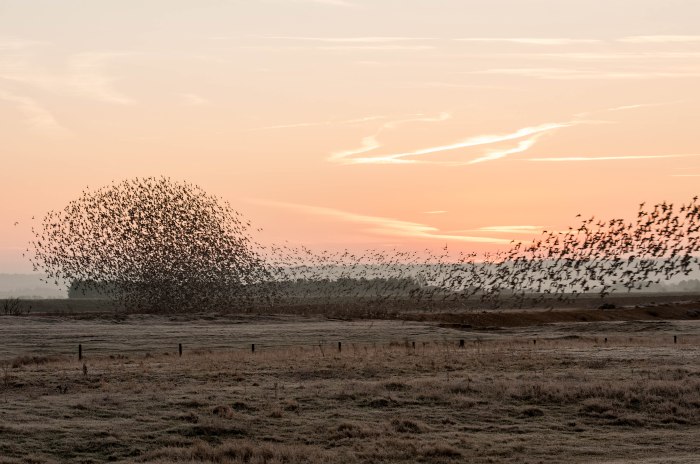 The sun is blazing as I begin the walk back to the car park but the frost still has a hold and a golden haze, backlit from the early rays of the sun, lies across the countryside to Sandringham and Wolferton. This Wash landscape is not mountainous; it’s not spectacular in the way the Lake District or the Highlands is, but it is just as significant to those of us who live here, and those who travel miles to see the geese and waders that are synonymous with it. This little corner of Norfolk contains a wonder of nature, and it is something that everyone should see.
The sun is blazing as I begin the walk back to the car park but the frost still has a hold and a golden haze, backlit from the early rays of the sun, lies across the countryside to Sandringham and Wolferton. This Wash landscape is not mountainous; it’s not spectacular in the way the Lake District or the Highlands is, but it is just as significant to those of us who live here, and those who travel miles to see the geese and waders that are synonymous with it. This little corner of Norfolk contains a wonder of nature, and it is something that everyone should see.
The Mangroves of Jardines Del Rey, Cuba
This is an essay which first appeared on Zoomorphic magazine.
The onshore wind is insistent like toothache. Waves break on the beach in long curls of white foam, and dissipate on the sand and are sucked back into the blue-green water. Sanderling and turnstone pick over weed the tide has strewn behind it, running before me in panic like peasants fleeing a raiding party, but resolutely refusing to fly. It’s a familiar scene, one I see almost daily on the beaches of North Norfolk. This, however, is not North Norfolk. As if to clarify this a pelican chooses this moment to fly into view. Unlike many of those beautifully streamlined diving birds – think tern or gannet – pelicans are big, bulky birds. With a laconic flight and a short, punchy dive, they turn slightly on their side before hitting the water with all the panache of a belly-flopping sumo wrestler.
To be honest I didn’t expect to see species common to my local beach here on a Cuban one. There was a definite double-take on my part when I saw the first sanderling running along in front of me. But, as I discovered later, there are also dunlin, sandpiper, turnstone and whimbrel here. There are different subspecies, such as the ruddy turnstone, to some of those we have at home, but it is still remarkable to me that here, in thirty-degree heat, with a mangrove swamp a few hundred metres away, there are the same birds doing the same things as there are four and a half thousand miles away on a Norfolk beach.
The beach that is before me now plays out a gentle curve which is whittled down to a point like a sharpened, smoothed piece of wood and at its tip is the mangrove swamp. I leave the beach here and wade out through a belt of thickly stinking mud and sargassum weed. It seems collected here purposely by a malevolent tide to keep me from reaching my goal. The water is mostly waist deep, but rises to my chest once or twice. I fight with the mud, sinking to my ankles. A bird as big as any I have ever seen launches itself from the mangrove edge and takes to the wing with deep, floundering effort. Whether it is its closeness, its unnatural-seeming whiteness, or the fact that I am used to seeing its smaller cousin the little egret that make it seem so, the great egret seems like a pterosaur.
After twenty yards or so the mud gives way to a mixture of bone-white sand and darker patches of turtle grass whose fronds beckon the tide on. The sea shallows to between thigh and ankle depth. Crabs gesticulate wildly with their claws like Latin housewives berating their husbands, and scoot away leaving a puff of sand like an exaggerated cartoon effect. I’m here on these sand flats for the first time ever to fish for bonefish and permit, but for now I’m bewitched. Luminescent wavelets harvest the sun’s rays like sheaves of golden corn, then sow them on the sand below in shimmering fields. Their never-ending kinetics scribe themselves onto my retinas, so that when I look away I still see the motion of them superimposed over my vision. Glossy ibis and little blue heron stalk the shallowest water. Royal terns with dark frowns pass me on the wind, and above them frigate birds cruise. A stingray melts across a bare patch of sand with a heat I am wary of, but passes me by gently, benignly even. I wander the flats in a carefree dream, wading amid the green sea, with the blue sky hinged above.
These sand flats and mangroves are extensive. If I followed them along the coast of Cayo Coco, the island on which I am staying, and then Cayo Romano and Cayo Paredon, there would be thousands of acres of them. Before the roads, before the hotels, before the seventeen-mile causeway from the mainland, before the international airport, this archipelago that stretches along the bent back of Cuba’s main island was uninhabited. Huge flocks of flamingos blushed the lagoons and mangrove edges, but the airport and the increased activity of tourism displaced them to more remote areas. Worryingly I am told there are already foundations in place for hotels on the currently still uninhabited Cayos Romano and Paredon, as well as those already half built here on Cayo Coco, and further North at Pilar beach. How much further can the pelicans be displaced?
Beyond a small mangrove-encrusted island that is like a dark green jewel set in a shimmering surround, the colour and mood of the sea changes from the benevolent blue-green of the flats to something deeper, darker, denser. I sometimes dream of being lost in a blank ocean, treading water over the black unending depths with the unknown and the unnameable somewhere below, and I think of this now as I look out across the ocean; out to where the Gulf Stream wells North as if pulsed by the ventricles of the earth itself.
The locals wade the kilometre or so out to this island to fish and gather conch shells. Some of them wave cheerily to me, and shout in Spanish, pointing to the island and indicating with outstretched arms what I presume to be the size of the fish that are to be found there. Life is a day to day struggle for the Cuban people. It is not a nice feeling to know the rod and reel I am fishing with are worth many months wages to the average Cuban. On a tour of the mainland later in the week our guide Laurie tells us he is a professor, and spent five years at university. He earns more in tips now than he did in wages as a teacher, but he still asks if we have any extra toiletries we can leave him when we go home because the shelves are often empty of everyday items. Because of this jobs in the tourist industry are highly sought after. My conscience struggles with the fact that though my being here is helping to provide well-paid employment, is that sufficient reparation for the crippling, spiteful economic embargo the US, and us as her ally, have enforced for decades? As an Englishman who is not altogether proud of his country’s history, or its exploitative colonial past, I believe it is important for us to engage with cultures and populations that have suffered at our hands historically. There is undeniably an element of exploitation where tourism in poorer communities is concerned, but without it there would be almost no interaction between the people of Cuba, and the people of countries such as our own. And according to the World Travel and Tourism Council, tourism accounted for almost ten per cent of GDP in Cuba in 2013. Where people’s livelihoods are concerned, my Western sentiments seem slightly hypocritical: if your children are hungry it must be difficult to care about whether some birds have to move. As a tourist myself who am I to pass judgement on whether or not tourism is ethical? Cubans are still of the land in a way we can only remember through pastoral-tinted glasses, and costume dramas. The industrial revolution was kicked into touch with the successive boots of the revolution, the economic embargo, and the collapse of the old Soviet Union, from whom Cuba used to receive much aid. Facts like this, and the enthusiasm of guides such as Laurie will, I hope, keep at least some of the island pristine.
On the walk back in to the beach I stay even closer to the mangrove trees because the mud is not as deep. Their exposed roots are countless thousands of intertwined fingers reaching down to the underworld and passing three environments – air, water and mud – on their way. Juvenile fish scatter like handfuls of leaves flung by a child onto an Autumn wind; the mangrove is the perfect nursery. Unseen birds with exotic, unfamiliar song call from deep within the maelstrom of roots, branches and leaves like sirens tempting me in. There is the overwhelming feeling of a blizzard of life contained within.
Because I am partially hidden amongst some of the outermost mangrove foliage the osprey doesn’t see me. It arcs overhead like lightning, and plunges in an unsuccessful strike mere feet from me. I am so close that as it lifts itself from the sea and pauses mid-air to shake like a wet dog, I see each individual drop of sea water flung from its feathers. There is somehow a split-second reciprocal meeting of eyes: the one a flaming fierceness of orange, the other an acquiescent yielding to a beauty complete in its wildness. It is something I replay over and over in the slow-mo, high definition of my memory; something that will always connect me to this place and this landscape and its cauldron of life.
Also ingrained in my memory is the graphic vividness of the landscape. Its energy is contained in its colours as much as its wildlife: the lucid sea, blue-green and restless, the white sand under foot, the sapphire sky above and the yellow-gold sun held within it. The individual colours are as separate from each other as utterly and naively as they are in a child’s painting.
By the time I have walked the mile or so back along the beach to the hotel, with a brief pause at the beach shack selling cold beer and grilled lobster, day is ending. There are no long evenings evocative of an English Summer here. By five ‘o’ clock the shadows of the palm trees are draped across the sand like the limbs of languid sunbathers lingering in the last of the sunlight, and by six the dark queen that is night in the tropics reigns. Frogs bat their croaks repetitively back and forth between palm trees and across the darkened pool. Later, in the hotel bar, a black-haired Cuban girl sings in French and Spanish with the heavy-lidded sensuality of a faded black-and-white era; an era before the revolution, when Ernest Hemingway drank daiquiris in La Floridita, and cruised these very islands in the stream on his boat the Pilar.
Significantly, the same treaty which protects the Wash – the shallow, square mouthed estuarine embayment I live less than a mile from – protects some of the Jardines Del Ray national park which encompasses these islands. The Ramsar Convention is specifically designed to protect the ecological importance and diversity of wetlands, whether they be the mangrove swamps and shallow sand flats of Cuba, or the saltmarsh and shallow seas of the Wash in East Anglia. It was negotiated through the sixties and ratified in 1971. Its mission is ‘The conservation and wise use of all wetlands through local and national actions and international co-operation.’ Currently in Cuba there are six Ramsar sites including the Gran Humedal del Norte de Ciego De Avila, which my rudimentary Spanish translates as the Great North Wetlands of Ciego de Avila, though I stand ready to be corrected. Here in the UK there are one-hundred and fifty-four including the Wash, out of a global total of more than 2000 covering an area of more than 200 million hectares. According to the Ramsar Convention wetlands are ‘Vital for human survival… among the world’s most productive environments; cradles of biological diversity… upon which countless species of plants and animals depend for survival.’
The Wash and the Jardines Del Rey may be more than 4000 miles from each other, but their fates are entwined on many levels. We do not live in isolation here on our own archipelago – much as some believe we should – and our wildlife and countryside does not either. Its biodiversity is linked to that of Europe, the Caribbean, Africa and the rest of the world, whether that be by migration routes, or the ability some species have to live in divergent landscapes. Just off Cuba’s shores lies the Sargasso Sea. The only sea without any coastlines, it is bordered by four currents: the Gulf Stream to its West, the North Atlantic Current to its North, the Canary Current to its East, and the North Atlantic Equatorial Current to its South. The Sargasso is the breeding ground of Anguilla anguilla, the eel we are used to seeing here in the UK. As leaf-shaped larvae called leptocephali they drift across the Atlantic on the Gulf Stream, metamorphosing into the more recognisable elver or glass eel, before migrating up our streams and rivers. Once they reach maturity they retrace their journey back to the Sargasso. The eel and its remarkable journey are just one example of nature’s ability to cross the borders that we have imposed upon ourselves. Our climate is driven by these same currents. The ocean conveyor belt is a global system of currents linking ocean to sea, and sea to ocean. Dependent on water temperature and salinity, it is the never-ending flow of countless gallons of sea-water that interconnects our seas with those of the tropics and the poles. But there is also an interconnectedness amongst those of us who believe, as per the Ramsar Convention statement on wetlands, that we are dependant upon our natural environments, and the millions of species found within them, just as they are dependant upon us. When an extinction occurs in Africa or the Arctic, we feel it here in England; it is a wave formed by the calving of an iceberg that reaches every shore on the planet.
Seeing a small, unobtrusive and quite ordinary bird going about its business on a beach in Cuba, at the same time as an exact copy is doing the exact same thing on a Norfolk beach, symbolizes the importance of nature to me as one living, breathing entity. Whether the Ramsar Convention will prove strong enough in the face of corporate growth to protect either the Jardines Del Rey, or the Wash, is something that concerns us all, even though most of us still have our heads either in the sand, or on our own personal crusade. The current détente between the US and her near-neighbour Cuba means, according to one estimate, that 10 million American tourists are on their way to Cuba’s shores quite soon, more than tripling current numbers. This, and the dismantling of the embargo, will be like a shock from a defibrillator to the ailing heart of the Cuban economy. In the face of that overwhelming economic energy I fear treaties such as Ramsar are going to need an awful lot of shoring up. Whether home or abroad these environments and habitats are essential for our survival as a species. While that may be the ultimate incentive for ensuring their continued protection and betterment, our responsibility lies equally to other species as to our own. Unfortunately, much of the world is neither watching, nor listening.
Dersingham Bog
‘Distilled by the sun, kneaded by the moon, it is renewed in a year, in a day, or in an hour. The sea changed, the fields changed, the rivers, the villages, and the people changed, yet Egdon remained.’ – The Return of the Native by Thomas Hardy.
The approach to Dersingham Bog is down the steep bank of an escarpment, and onto a valley floor the depth of which is exaggerated by the soaring pines on its sides. The worn earth of the path along the valley bottom leads over the heaved undulations of tree roots. Since I was last here a massive Scots pine has been felled, its limbless trunk is stretched quietly next to the dark heart of the corrupted stump. After fifty yards or so, the pines give way to newly-greened silver birch; the slender frames of young trees gathered together like a group of nervous fawns shivering in the fading breeze. The valley is formed by two outstretched arms of the escarpment reaching towards the Wash which lies out of view, beyond more pine plantations of the Sandringham Estate, and a mile of glacier-skimmed farmland.
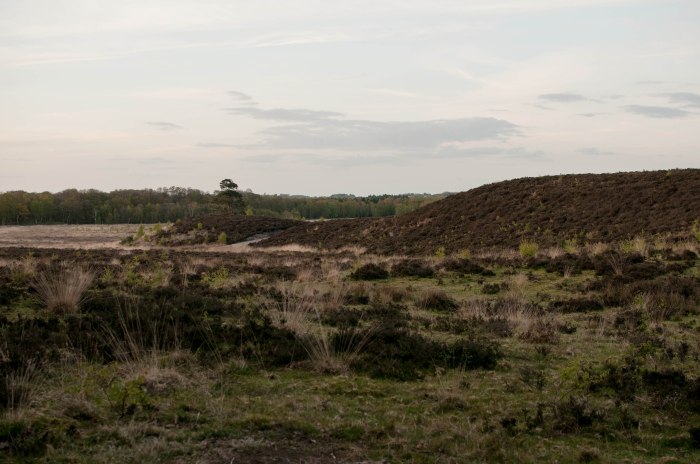
After another couple of hundred yards the valley opens. The spur to my right is cut in two by a deep path that follows the foot of the escarpment where once the sea reached; now it is waves of ling heather that break upon the hills. This is a heavily managed environment, the irony of which lies awkwardly across the darkening landscape. This is one of the few remaining ‘wild’ places left amongst the farmland of Norfolk; much has been surrendered to the ingress of intensive agriculture and its anachronistic partner game-shooting in sorry capitulation. I have nothing in principal against game shooting, I enjoy eating it in season, and it is something that I have often considered trying, but I don’t buy the idea that we should somehow be thankful for the way our landscape looks today because of it. That suggests if landowners didn’t have an interest, either recreational or financial, in providing suitable habitat for game birds, then we would have witnessed an even more drastic reduction of hedgerows and other habitats than has otherwise taken place. Surely nature for nature’s sake should be enough, not nature as by-product of financial dogma? What’s more I find it impossible to reconcile the fact that indigenous species labelled as ‘vermin,’ are exterminated in their thousands to protect the thirty million or so non-indigenous pheasants released every year with the sole purpose of being shot. Is it me or does the absurdity of that situation seem impossible to fathom? Again, I am not against certain species being culled as and when necessary to protect vulnerable or endangered species, but it is the indiscriminateness of game-keeping, mired as it is in Victorian attitudes, that must change. But I digress. It is Natural England who attempt to keep the three key habitats of mire, heath and woodland here intact. Lowland heath such as this was formed by the clearing of woodland for fuel and grazing during the agricultural revolution when we moved from hunter-gathering to farming. According to the Wildlife Trusts there are now only 58000 hectares of this habitat left in England – a sixth of what was present at the beginning of the nineteenth century – and it continues to disappear at approximately fifteen per cent every decade. To add insult to this injury seventy-five per cent of what remains is rated as in poor condition. But still these petri dishes of heathland, bombarded by the antibiotics of intensively farmed agriculture, are refuges where many species bloom. Reptiles such as adders thrive here, but population isolation and the subsequent reduction in genetic diversity puts their long-term survival in an uncertain position. Five thousand species of invertebrate inhabit heathland, and some very specialist birds, including the Dartford warbler, though they are currently restricted to further South, and East.
Maybe one of our most famous areas of heathland is actually fictitious, or semi-fictitious anyway. The Egdon Heath of Hardy’s Wessex landscape is said to be made up of the many areas of heathland that existed at the time he was writing. That more irony seeps across this landscape is apparent in Hardy’s words above, for in fact if Egdon had existed in reality, it would now be as endangered as the genuine article.
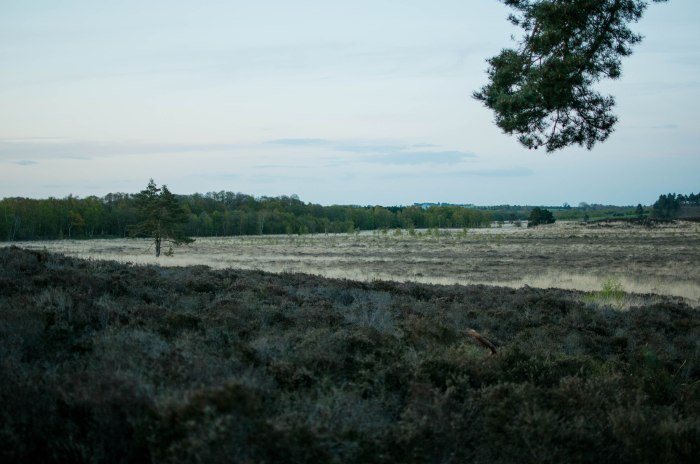
The escarpment is behind me now, and I am amidst the open heather. Below, the bog that gives this reserve its name stretches to a small, still lake, beyond which more pines hem the reserve in along the line of the coast road. The light and breeze of day are gradually failing, though it wants half an hour at least before true twilight. Some of the creatures of the day are still active, although behind me I can see a roe deer buck silhouetted on the curving spur of the valley. He stares back at me before slipping away. Pheasants give their familiar rasping calls: ‘Chooor-chuk!’ The abrupt, upturned ‘chuk,’ is followed immediately by a drumming of wings: ‘Chooor-chuk! Brrrrrr.’ A cuckoo calls from an isolated pine that stands amidst the heather.
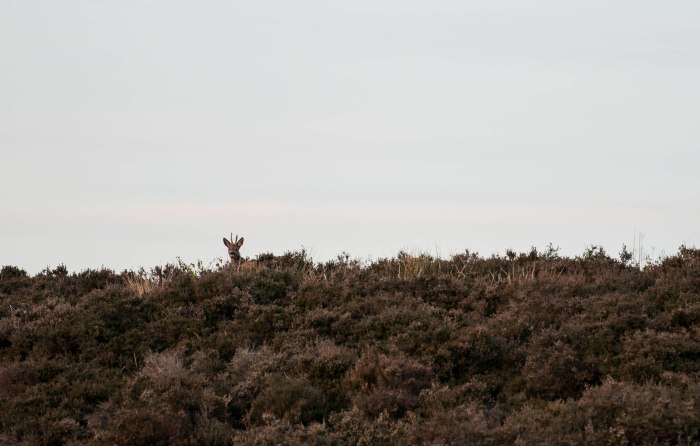
Scrolling curlicues of cirrus are beginning to pink as the sun sets, and there is a brief moment of handover from the day shift to the night shift. There is a bit of overlap – the occasional ‘Choor-chuk!’ – but as the light really begins to fade, the night shift takes over. It may be rather clichéd but there really is the wavering hoot of tawny owls, and the sharp, acid bark of a fox. There is also something else, though still not what I am actually here for. ‘Groak-groak-gr-gr-groak. Tsew! Groak-groak-gr-gr-groak-groak.’ The portly bird with the strange, croaking call passing overhead is a woodcock. He continues his night-time foray with a steady, straight flight to the far side of the reserve. Staying just above tree-top height he swings round along the line of the pines and then over again all the while continuing his weird, throaty groaking, and single, high pitched ‘tsew!’ This tree-top flight is a courtship display named ‘roding.’ The woodcock is a quarry species, meaning they can be shot in season, though they are apparently notoriously difficult to hit because of their small size, and jinking flight. Preparing it for the table is relatively easy. Once plucked and roasted, the guts are removed, and spread on toast. The bird itself is then served on top of the toast upon which its guts are spread. You may also, if so inclined, suck the brains from the skull; they are supposedly particularly good, though I prefer my woodcock groaking overhead on an evening such as this.
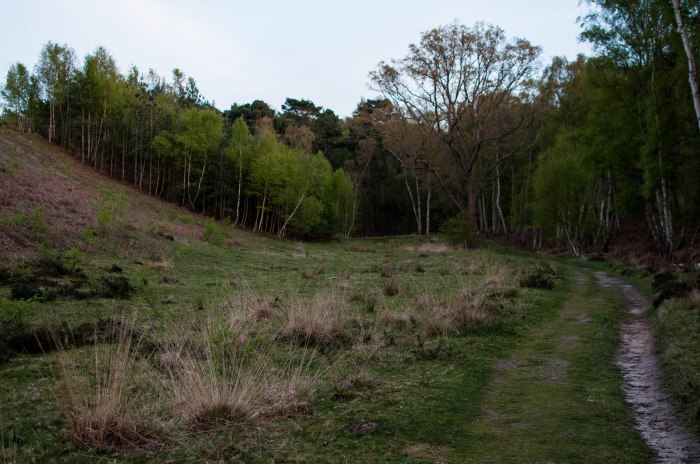
Weird and lovely as the sound of the Woodcock is, it is not what I am here for. In Spring nature’s afferent unpredictability is at its best, bubbling up through Winter’s mantle, and dependant on the whim of the wind and weather not just here, but thousands of miles away. But it so happens that tonight Spring has flowed into this little corner of Norfolk, and somewhere out amongst the heather, the nightjars are waking from a day of hidden slumber. The churring of the nightjar is a difficult sound to describe. It’s a throaty, rolling churr that swells and then surges as more birds join in, then fades and falls, before rising again. Once the birds leave the cover of the heather to feed on the moths, and other insects which they catch on the wing, they are visible through the gloaming. Their wings come together in an occasional loud clap, and the daubed whitewash on each wing, and opposite corners of the ends of their tails, flash like semaphore lamps through the gloom. In flight they utter a single ‘Koo-wick,’ call, while clap-clap-gliding with wings in a v, and broad tails fanned. The nightjar was once known as the goatsucker because of the belief that it stole milk from the udders of goats. Creatures of the night were commonly associated with superstitions such as these. It has been a shorter display this year than some I have seen, only one individual coming close enough for me to see.
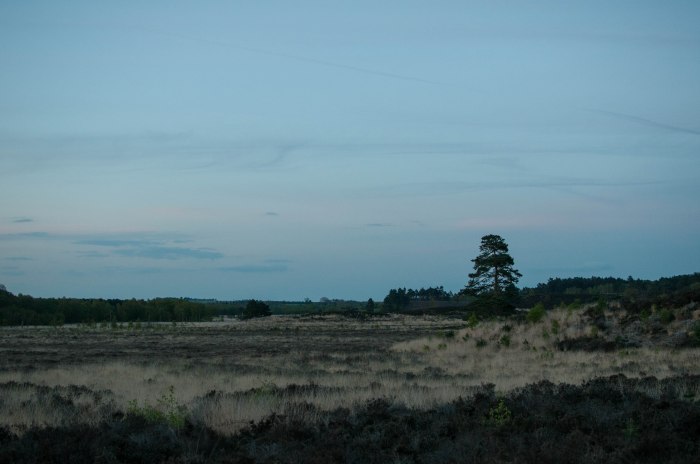
I don’t feel scared at night in the countryside; today there is more to be feared walking through the local town centre at this time. There is though, the natural apprehension of the dark as I approach the narrow reach of the valley on the way back to the car, where the pines are looming totems; heads somewhere high in the shadows. There are cracks and rustles in the bracken and heather. Two fallow deer start near the birches. I watch their pale bellies as they go up the hillside in impossibly long bounds, and stop at the top to stare down at me like the roe deer earlier. The anxiety induced by modern society dissipates out here, alone in the dark, with the calls and sounds of the wild.
From Dunwich Heath to Minsmere
Lying over Dunwich Heath, across the low, crumbling cliffs, the shingled beaches and the milky-calm seas, is an indistinct haze; half-remembered realities are hidden in the silt of cloud that billows over the landscape. I know to the North is the lighthouse at Southwold, and in the other direction the upturned, half-buried eggshell of the nuclear reactor at Sizewell, but both are obscured within the opacity. I don’t know where they are because I have seen them from this place before, but I still know they are there. It’s a strange sensation akin to déjà vu. Memory can be a strange and often idiosyncratic fellow. I often remember dreams when I first wake, then forget them minutes later. I remember remembering them, but can’t actually remember them, and this is how I feel now. It’s like a kind of ersatz déjà vu. Well, it would be if déjà vu itself were real I suppose. But then that’s the thing about déjà vu isn’t it? Is it real? Is it a lost memory? Or is it a fake memory triggered by something read or seen many years ago? I find, like my dreams, that I can sometimes very quickly forget what the déjà vu was about.
Above the gently swelling sea, which breaks in long, slow exhalations that heave the bosom of shingle back and forth, Dunwich Heath’s gorse is flowering in a brawling tumult of yellow, its giddy essence of coconut flavouring the air. On the sea itself, crepuscular rays shine in sidelong glances onto a single fishing boat, and suddenly both lighthouse and nuclear reactor are visible. Reality is restored; real memory formed. The two landmarks are at opposite ends of a concave reach of coastline like the bend of an undrawn bow, but they are being tuned in and out of visibility like a dodgy radio signal.
From Dunwich Heath car park, Minsmere – one of the RSPB’s flagship reserves – is laid out in panorama before me. It is almost ten square kilometres of reed bed, scrapes, shingle vegetation, and lowland heath, amongst other habitats. From here, open spaces within the reed beds are visible where the secretive, elusive bittern picks its guarded way between reed stalks, the stiletto of its bill drawn, ready for a stabbing thrust at fish or frog.
We walk down the sandy embankment from Dunwhich Heath car park onto the beach, and turn towards Minsmere. Each footfall meets the shingle in a satisfying scrunch of stone on stone, the smoothed surfaces rotated around one another by wave after wave in a grinding orbit. Inside Minsmere itself we follow a raised path inland that splits the reed beds. A quarrelsome swan, wings held aggressively out like an elderly lady elbowing her way to the front of the queue at M. and S., propels itself along a channel through the reeds with aggravated thrusts towards two greylag geese seemingly minding their own business. Though the reeds offer protection to various species, they are beautifully lissome, each an individual strand of slender blown glass stretched into a thread. But when two bearded tits alight on adjacent stems they don’t give way or shatter, merely sway under the birds’ delicate frames.
The beards of the male bearded tit are in actual fact rather magnificent, drooping, jet-black Fu Man Chu-style moustaches, a la Peter Ustinov in the classic kids’ flick One of our Dinosaurs is Missing. That however, is to do them a great disservice, because the males are little stunners. They wear a smoky, blue-grey hood, their backs and wings are the honeyed-orange of a late Summer evening, and the softness of these colours contrasts so perfectly with the twin triangles of their manicured moustaches. We watch them flicker through the reed stems; the urgency of Spring in every movement. The colour of their wings and backs is actually very similar to the colour of the reeds themselves, affording some concealment from any predatory eyes on high. This effect of light and dark exists throughout the natural world from fish, to birds, to mammals. Shading is a visual cue that may help predators recognise prey items in three dimensions despite camouflage, and countershading is possibly an evolutionary reaction to this. It’s a remarkably simple, but ingenious strategy, that works both ways: predators use countershading to their advantage too. Though there are variations in individuals, many predators, from peregrines to great whites, have a pale underbelly and darker back, meaning they are less visible from below, with the light above them, and also less visible from above, with a darker background beneath them.
If you were to get an empty bottle and blow across the top of it, you would be hearing something like the bittern’s boom. It is a sound with an esoteric quality; one that many people may just not hear, or to be more precise, not notice that they are hearing, which is the same thing. I have heard a bittern once, before today. Walking back to Burnham Overy Staithe along the sea wall from the beach, the sound of the bittern’s boom reached me from somewhere amongst a small reed bed in a field full of cattle. In a way it was such a subtle sound it seemed to come not from within the landscape, but somehow behind it. It was only when my subconscious self reluctantly surrendered the sound to my conscious self that I realised I had been hearing it for a while. It was almost a eureka moment, and the same happens today at Minsmere. We stand and listen as two or three more booms, in addition to the two or three that we heard before we realised we were hearing them, resound across the landscape. Most of the families here today are heedless of the booming, only a few other people like ourselves stopping in their tracks to listen to this most fascinating of bird calls.
Nature and landscape exist as if in layers; layers of reality. Some people are content to walk on the surface, never minding what’s beneath the ground, and preferring the solid feel of macadamised byways through life. Others are not content with this version of the world, but seek the places and ways where the layers split and delaminate; where nature and landscape are flung up and revealed like geology. It is not enough to live life on a straight-paved road, we should wander the woods, climb the mountains, comb the shorelines, peer in to the reed beds, and listen for the bittern’s boom; it speaks of a reality which may one day fade from all our memories.
No man is an island
An article first published on The Island Review website:
Spring
Spring is upon us, meteorologically anyway. We may not feel it in the raw winds or the several inches of snow that fell overnight on parts of the North, but it will become more apparent with every passing day, gathering pace like a cavalry charge that started as a walk, progressed to a trot, a canter, and then a full blown gallop that bursts through Summer’s defences. There will be some stumbles along the way no doubt, Winter is ever the worst hanger-on, like drinkers in a pub after last orders eking out the dregs of their pint, but there’s that inexorable something in the air that everyone, and every thing, feels. Yesterday under a blue sky, the hedgerows were beset with birds busying themselves frantically with preparations for the coming season. Blue, great and long-tailed tits dart, flicker, flash, scud and sail from bush to bush and twig to twig, occasionally disappearing within the confines of the ivy that in places smothers the hedges.
This time of year can feel schizophrenic. One minute I’m bathed in warm sunshine, sheltered from the breeze and positively warm in hat and gloves, and the next I’m in the shade at the edge of a pine plantation, where frost still hardens the grass between the bare earth of the sheep tracks, and the breeze furrows the air like the plough has the brown fields. Then a skylark starts to sing, its song climbing like a curl of mist in a shaft of sunlight; the seasons snapping back and forth between personalities.
Birdsong has the same ability that music has to transport me out of body, to a time, a place, a feeling. Dinosaur Jr’s Freak Scene takes me back to legendary alternative nightclub the Pink Toothbrush in Essex, The Wedding Present’s George Best, to the pain of teenage love. A skylark’s song never fails to plant me on a footpath in the village I grew up in, alongside a field of ripening corn, a well-loved shaggy Airedale terrier like an old rug beside me, while the yellowhammer’s a-little-bit-of-bread-and-no-cheese lament takes me to a Summer evening in a different village, and my grandparent’s house that now I only drive past. Half-remembered moments of childhood, like closed-up rooms in an attic suddenly filled with sunlight.
Swinburne wrote ‘When the hounds of Spring are on Winter’s traces, The mother of months in meadow or plain, Fills the shadows and windy places, With lisp of leaves and ripple of rain.’ The only leaves lisping today are those of the tree ivy, most of the hedges and deciduous trees are still bare, but there is a watchfulness over the landscape – the ‘Mother of months’ is waiting, and very soon buds will begin to open, leaves unfold, and crops green the rich brown of the fields.
Along the riverbank where I walk, amongst the grass clumps tussocked into wigwam shapes, a wren in her humble brown pinafore shows herself briefly before disappearing shyly like a reclusive old lady. She leaves her song behind her, and it follows the river-water in a spate towards the sea, spilling over the sill of a little weir, and weaving under the willows that sentinel the bank, as clear and lustrous as the chalk-filtered water itself. Again I time-hop more than thirty years, to another wren, in another place, that sang just as sweetly from the corrugated roof of a tumbledown shed where we ran as wild as the garden sometimes grew, this time with a floppy eared, soppy black mongrel at our feet.
Overhead a buzzard soars on the sky, mobbed by four rooks like whirligig beetles round a leaf turning slow circles on the quiet current of the river beside me. Its keen call is answered by another that drifts into view from above the pines where I think they are nesting. Very soon Winter will be the distant memory that Spring’s growth, and Summer’s warmth, will make it.
High tide at dusk, Brancaster
Scolt Head Island
This is an essay originally published by The Island Review website.
At low tide, if you don’t mind getting your feet wet, you can walk to Scolt Head Island’s eastern end across the sand and through the mud; you’d better not stay too long though, and you need to take careful heed of the tides and the weather, because once the tide begins to flood, begins to roll boisterously through the channel between the island and the mainland, Scolt Head becomes that most magical, and often unreachable of things: Scolt Head becomes an island. It becomes an object of desire, of jealousy even. Mere pedestrians, those who have walked out behind the retreating tide like waders searching for tit-bits, and then hurried back ahead of the tide on its return, have only had a couple of hours on the island and are now condemned to the car park to pack their empty picnic baskets and damp towels away, and return to their land-lubbing existence.Scolt Head Island’s house-high dunes are visible from the car park at Burnham Overy Staithe harbour. They’re mohicaned with marram grass, amongst which delicate bee and pyramidal orchids hide. On the other side of the island the approaching tide glitters in the sun, the waves tipping and tumbling over themselves as they advance from far out across the beautiful emptiness of Holkham Bay.
Meanwhile back in the car park, the mood of those who the tide has banished is not improved by the rising gaiety and bustling activity of the newcomers filling up the spaces in the car park of those departing: the island-goers are here.
Dinghies, dumpy-looking retired Norfolk crab boats – which always put me in mind of Gerry Durrel’s Bootlebumtrinket from My Family and other Animals –inflatables, canoes, kayaks, fishing boats; whether powered by wind, oar or diesel a veritable flotilla of small craft are readying themselves for departure. Picnic hampers are loaded, cool bags and barbecues stowed; sails flap eagerly in the breeze; halyards and various other items of rigging ting-ting-ting impatiently against mast-heads; outboards idle contentedly.
The tide is on its way; creeping across the vast expanses of sand and mud, filling the gullies and channels that web the saltmarsh, lifting strewn weed that it left on its last visit, gently prising boats from their muddy moorings with a satisfying schlurp, and pushing the oyster catchers, greenshanks, curlews and various other lanky-legged waders off of their feeding grounds, it seems to gather pace exponentially as it approaches land. There’s a greediness to an incoming tide that is only truly appreciable if you are somewhere like the North Norfolk coast; where the sand slopes gently from the beach, where there are deep gullies that deepen further each year, or sometimes change direction, or disappear altogether. The tide’s hunger, along with the wind, can change this landscape beyond recognition year to year. And, if you’re out on the sands when the tide turns, you will see the speed with which it can devour the land. The sand is corrugated like a metal fence, and the ridges and depressions are alternately filled and crested by the sea as it approaches the beach. The metaphoric sense of renewal is obvious. Twice a day the tide returns, erasing the sands of footprints, driftwood, weed, and all the flotsam and jetsam of the previous tide. There are few landscapes affected by such a constant sense of renewal. Most natural landscapes have a sense of permanence that give our lives constancy. Mountains are formed over millennia, trees decades. But our coastal landscape uniquely has the ability to undergo a radical and dynamic change without being under our control. It’s one of the things which attracts people to it time and again; not so much a true sense of wildness as a genuine one.
Scolt Head Island is a classic example of what geographers refer to as an offshore barrier island. It was leavened from wind and tide in the geological blink of an eye; around a thousand years ago is the latest estimate, and it probably started life as a spit of sand that spread westward over a shingle skeleton. It would have been colonised by marram grass seeds blown on the wind or transported by birds or the tide. Once the grasses take hold, their creeping roots hold the sand together and in this way dunes begin to develop. Now the island is four miles long and growing: reaching from Burnham Overy Staithe at its eastern end to Brancaster at its western, this eyebrow of dunes and shingle atop the North Norfolk coast contains four significant habitats: shingle, intertidal mud and sand flats, sand dunes and saltmarsh. According to Natural England, who manage this National Nature Reserve, the saltmarsh of Scolt Head Island is the finest in the country, and is apparently the most studied of any in the world. Its inaccessibility is one of the things that makes it so special. For much of the year, apart from researchers, the island is empty of humankind. Only in the Summer is its eastern end the playground of the privileged picnickers. The island is accessible year round, only the ternery at its western end is out of bounds during the breeding season, but unless you come on one tide and leave on the next your time to explore is limited. Apart from predator control there is a non-interventional approach to the island and its wildlife.
My fascination with islands began in childhood with Arthur Ransome’s Swallows and Amazons. Wildcat Island was the first island that I dreamt of. I’d get in to bed with the light on and either read until I fell asleep or, when I heard my mother coming up the stairs to check on me, hide the book under the covers and pretend to be asleep. There was just light enough from the hallway to carry on reading once she’d turned my light out and gone back downstairs. Then there was Treasure Island, and the Famous Five’s Kirrin Island; islands were the most exciting places in the world, full of secret tunnels, treasure, pirates, all the things that an impressionable young boy couldn’t resist. And as I got older there was Klovharu, Tove Jansson’s retreat. It’s not the pirates or the thought of buried treasure that keeps me interested now, though there is still something fascinating about islands for me and others. Maybe it’s the fact that we are all, in essence, islanders: Great Britain is itself made up of over six thousand islands.
In the Summer months, as well as those privileged enough to be able to get there under their own steam or sail, there is a small passenger ferry that chugs its way from Burnham Overy Staithe harbour, out past the sea wall on the right and the vast expanse of salt marsh on the left, to the golden sand of Scolt Head Island. Most people set up their picnics on beach there and then, perhaps a little wary about roaming too far from where the ferry will pick them up again later, and not without some cause for concern, for the Wells lifeboat has had to rescue the unwary in the past. And while they won’t have to wait so long that they’ve built up a raging desire for cheese a la Ben Gunn, it must still be a little disconcerting to be left behind, though I admit to a little frisson of excitement at the prospect myself, and though I do like cheese I could easily give it up for few months on a desert island.
Islands get deep in to your psyche; their enigmatic loneliness enthralls me. Maybe it’s a desire to retreat from a society where everyone is increasingly linked by mobile, or email, or ever-decreasing housing on ever-decreasing housing estates; the constant pressure to conform, to get a job, a mortgage, a better, bigger, newer car than the neighbours. While those at the other end of the scale have an infinite ability to isolate themselves the rest of society is forced to homogenise, to live the same, think the same, behave the same. Escaping to the countryside is many people’s pressure valve. Whether turning that valve leads them to the hills or the coast to relieve the pressure it is what keeps many of us sane. Our landscape should be available for all, not just those privileged enough to be able to live in our most beautiful places. Landscape has meaning to many, from profit to wonderment and many shades in between. It should go viral, should be disseminated out and across our entire population, not held close between those few who consider themselves its guardians, but in fact are its jailers.
The Great Nature Writing Debate
Other – better – writers than myself have recently dug over what place nature writing has in the modern world, and some have even gone so far as to state some of the most respected nature writers of today are fiddling while Rome burns. At the risk of getting way out of my depth I will venture my own opinion on nature writing today (And I’ve even, unintentionally, managed to get a Wedding Present song-title within the text!).
Observing nature has been a human activity for as long as Homo sapiens has existed. When we lived as hunter-gatherers observing nature would have been the most essential skill anyone possessed. They would have been experts in what fruits, berries, grasses and roots were safe to eat, as well as where and at what time of the year they were to be found; they would have known the life-cycles, the habits and the habitats of countless species of bird, mammal, reptile, insect and fish; they would have known the nuances of the weather, which rivers were liable to flood, and when and where it was safe to make camp; they would have known spring tides occur at the new and the full moon, and that as well as the incoming flood tide being higher than usual, the outgoing ebb tide would be correspondingly lower than usual, perhaps revealing beds of shellfish not normally accessible. Knowing all this, and more, was crucial for the survival of themselves and the groups they lived in, and for us as a species. When Homo sapiens actually began documenting what they observed is debatable, but we do know that 40,000 years ago, in what is now Germany, a human being identical to ourselves carved in mammoth ivory what is known as the Lowenmensch – the lion-human. Due to a dispute about whether the figure is half-man, half-lion or half-woman, half-lion the original name of Lion Man of Hohlenstein Stade was sensibly amended. It is widely thought to be the oldest anthropomorphic likeness produced by a human being. 35,000 years ago, another human being painted a picture of a type of pig on the wall of a cave on the island of Sulawesi. Next to it there are hand silhouettes from the same period in time as the lion-human from Germany. Hand silhouettes such as these have been found as ancient cave art in places as diverse as France, Borneo, Argentina and Australia. Archaeologists and anthropologists are still unsure of their meaning. It must have been, at least partly, a yearning to document, to leave a mark, to eternalise themselves in that particular place at that particular time.
Independently, at a similar time, different groups of ancient, but modern, human beings were documenting the natural world and even, to an extent, fictionalising it. It was the single most important factor affecting their lives and they were consciously recognising, and recording it. Today the natural world remains the single most important factor in our lives. Though we may have domesticated aspects of it, we still rely on it for everything, whether that be food, water, fuel, heat, transport, electricity, or the internet. Without the existence of the natural world and its resources the human race could not, and would not, exist as it does now.
Unfortunately, many humans of today have lost sight of the natural world. Some have never had sight of it, and never will, whether that be through choice or lack of opportunity, and others are forced to abuse it out of necessity. As well as this, there are those who see it as a series of endless resources to be exploited in the pursuit of profit and the all-conquering dogma of capitalism – growth. Writing on nature – as well as writing on landscape and place, for all three are compounds of the same alloy – should, and does, go a long way to countering all of the above. Unlike the many charities and other organisations promoting conservation, recycling and other so-called ‘green’ agendas, nature writing celebrates nature for nature’s sake. But that is not to say it doesn’t promote its conservation. The realisation that something is beautiful and essential and alive, has a deep-reaching power that in these days of austerity, charity-fatigue and backlash, a mere request for outrage and funds can never match. To have your eyes opened wide by nature writing is inspirational and motivational, and once you’ve been moved by the written word, it is but a small to step to be moved by the reality. Nature writing engenders a wont to care, not just set up a direct debit to make you feel you are ‘doing your bit,’ though this is important too. Nature writing does not have to have a specificity aimed at conserving a habitat or a species to be considered a valid part of conservation; it is as important to conservation of landscape, place and nature as any charity campaign, or more targeted piece of conservation-minded writing.
Have human beings have ever been ‘at one’ with nature? Certainly not now, and not before the industrial revolution, and not before either the agricultural revolution of ten thousand years ago – when we moved from hunting and gathering to farming and domestication – or the cognitive revolution, which began seventy thousand years ago. The people who carved the half-lion figurine, or left their handprints on cave walls thirty or forty thousand years ago, may have lived cheek-by-jowl with nature, and relied upon it in a more direct way than we do today, but they certainly weren’t worried about conserving it. As a species, extinctions have tracked us through the ages with the dogged persistence of a bloodhound on the trail of a convict.
There are three main extinction events which carry the tell-tale evidence of our modus operandi, and identify us as the serial killers that we are. The first wave occurred with the onset of the cognitive revolution, when Homo sapiens left East Africa and spread through the rest of the world over the following sixty thousand years or so. The fossil record shows time and time again that our appearance coincides with the disappearance of countless other species, including large mammals such as the mammoth, and also every other Homo species. The second wave came with the agricultural revolution, when our population began to grow with the domestication of crops and animals. The third wave, if you hadn’t guessed it, is happening right now, and once again it is Homo sapiens driving it. But this time the consequences are potentially catastrophic to us as a species as well.
Nature writing is as diverse as the natural world itself. As that diversity shrinks, so does our awareness of it. We do not realise that without the existence of the natural world our games consoles will also cease to exist, as will our mobile phones, and our internet connections and every other aspect of modern life. Nature writing is essential if we are to re-connect ourselves with our landscapes, and the species within those landscapes. If we are to save the wonderful and beautiful and amazing species that we live amongst we must identify, and understand our roles within their lives and their habitats. But preaching to the converted is pointless, as is preaching to those who are not willing to listen. We must have more than charitable demands, more than angry calls to arms, more than the belief that literature can influence our political classes, as has been claimed in this debate. We must have all those things of course, but we must also have more: we must have inspiration, we must have insight, we must have contagious enthusiasm, impulsiveness, and we must have awakening and arousal. And we must affect people first: ordinary, run-of-the-mill people. Not politicians, not the wealthy, but the ordinary. Real change will only come from the bottom up, there is no will for change to come from the top down, only a thirst for more resources and more profits. And nature writing can help orchestrate real change. All nature writing can. There is room for all under the canopy of the great tree that is nature writing. Let’s hope that by the time we’ve finished bickering amongst ourselves as to who has the right approach, that tree is still standing
